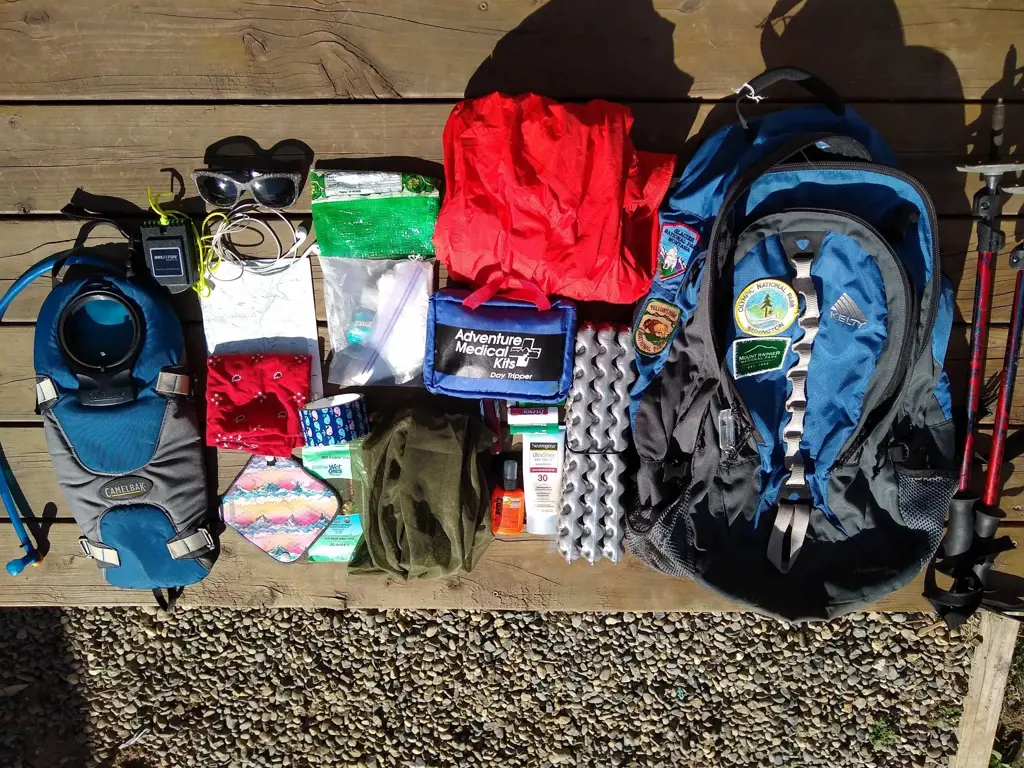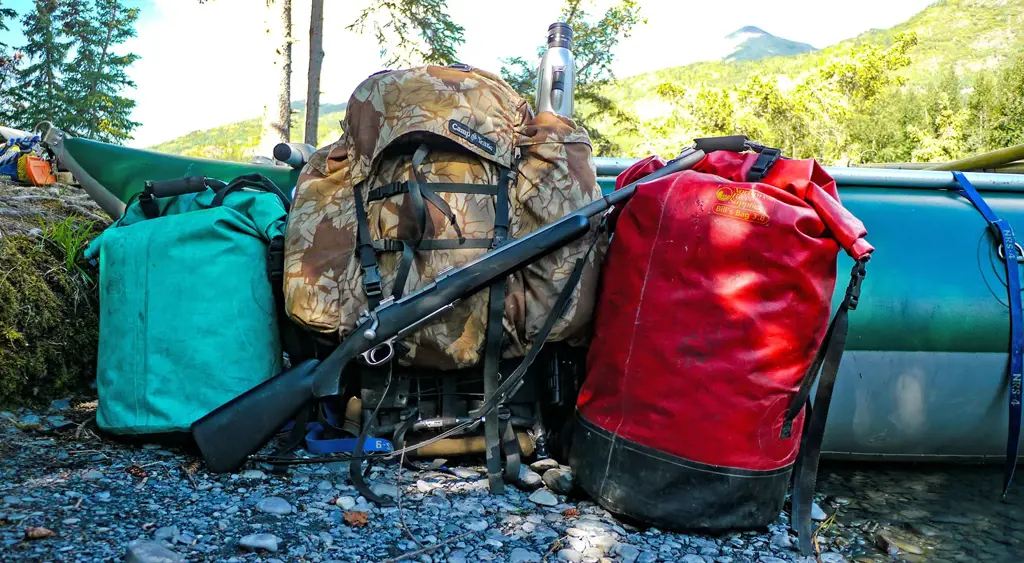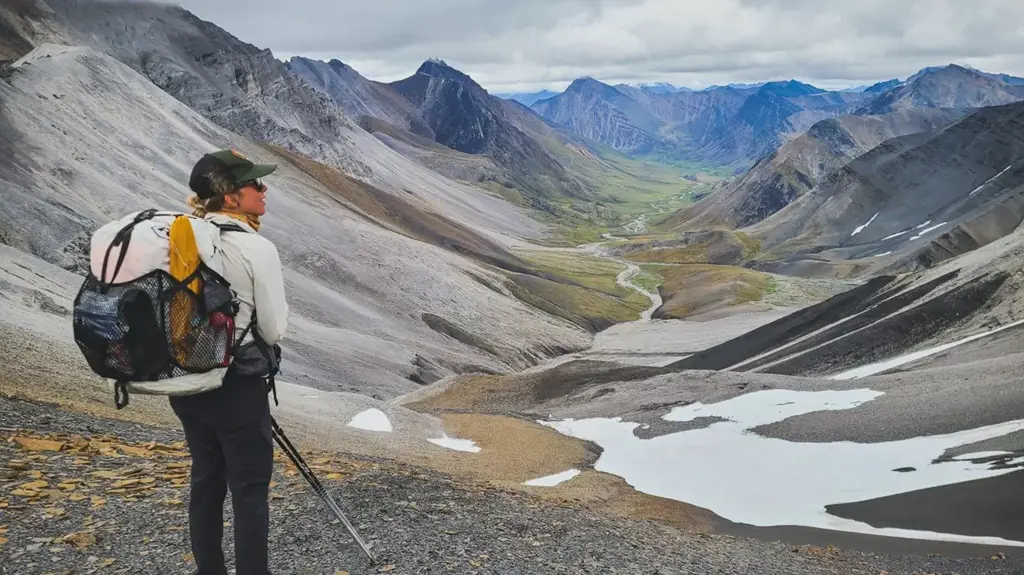
Hiking in Alaska is a unique and unforgettable experience, but it also requires careful planning and preparation. The rugged and unforgiving wilderness of the Last Frontier calls for essential gear and items that will ensure your safety, comfort, and enjoyment during your hiking adventure. From the right clothing and footwear to navigation tools and bear deterrents, this guide will provide you with the essential gear and items to pack for hiking in Alaska. So, whether you're planning a day hike or a multi-day expedition, equip yourself with the proper gear and get ready to be amazed by the breathtaking beauty that awaits in Alaska's untamed wilderness.
| Characteristics | Values |
|---|---|
| Terrain | Mountainous |
| Climate | Unpredictable |
| Temperature | Varies from -10°C to 20°C |
| Clothing | Layered system |
| Footwear | Sturdy hiking boots |
| Backpack | Waterproof and durable |
| Tent | 4-season |
| Sleeping bag | 0°C temperature rating |
| Food | High-calorie and lightweight |
| Water | Filter or purifier |
| Navigation | Map and compass |
| Illumination | Headlamp |
| First aid kit | Comprehensive |
| Communication | Cell phone or satellite communicator |
| Survival | Fire-starting kit and emergency blanket |
| Insect protection | Mosquito repellent and head net |
| Wildlife | Bear spray and bear-proof food storage |
| Waste management | Zip-lock bags for waste |
| Tools | Multi-tool and duct tape |
| Emergency shelter | Emergency bivy or tarp |
| Personal items | Sunscreen, sunglasses, and hat |
| References | Guidebook and trail maps |
What You'll Learn
- What are the essential items I should pack for hiking in Alaska?
- What types of clothing are best for hiking in Alaska's unpredictable weather?
- Is it necessary to bring special gear or equipment for hiking in Alaska?
- Are there any specific items or supplies that are unique to hiking in Alaska?
- Are there any safety precautions or emergency supplies I should pack for hiking in Alaska?

What are the essential items I should pack for hiking in Alaska?

Hiking in Alaska offers some of the most breathtaking scenery and unique wildlife encounters in the world. To ensure a safe and enjoyable hiking experience, it is important to pack the right gear and essentials. The rugged terrain and unpredictable weather conditions of Alaska make it essential to be prepared for any situation.
Here is a list of the essential items you should pack for hiking in Alaska:
Clothing:
- Layered clothing: Pack multiple layers of clothing to adjust to the changing weather. This includes a base layer, insulating mid-layer, and a waterproof outer layer. Opt for moisture-wicking materials to keep you dry and warm.
- Hiking boots: Invest in a sturdy pair of hiking boots with ankle support and good traction. This will provide stability and protect your feet from the challenging terrain.
- Hats and gloves: Pack a warm hat and gloves to protect yourself from the cold temperatures, especially at higher elevations.
Navigation:
- Map and compass: Carry a detailed map and a compass to navigate the trails accurately. Familiarize yourself with the map before setting off on your hike.
- GPS device: Consider bringing a reliable GPS device to track your movements and to help with navigation, especially if you are hiking in remote areas.
Safety equipment:
- First aid kit: Pack a comprehensive first aid kit that includes bandages, antiseptic ointment, painkillers, and any personal medications.
- Emergency shelter: Carry a lightweight emergency shelter such as a bivy sack or a small tent to protect yourself from extreme weather conditions or unforeseen circumstances.
- Bear spray: If you are hiking in bear country, it is essential to carry bear spray as a precautionary measure.
Food and water:
- Water filtration system: Carry a water filtration system or purification tablets to ensure a safe water source during your hike. Streams and lakes in Alaska may look pristine but can harbor harmful bacteria.
- High-energy snacks: Pack a variety of lightweight and high-energy snacks such as trail mix, energy bars, jerky, and dried fruits to keep your energy levels up during the hike.
Tools and accessories:
- Multi-tool: A multi-tool with various functions, including a knife, scissors, and screwdrivers, can be handy for any unexpected situations during the hike.
- Headlamp: A headlamp is crucial for hiking in Alaska, as the days are long and nights can be dark. It will help you navigate the trails and set up camp after sunset.
- Backpack: Choose a backpack with proper support and ample space to carry all your essentials comfortably. Opt for a waterproof or water-resistant backpack to protect your gear from rain or snow.
It is important to note that these are general guidelines, and your packing list may vary based on the specific hike and season. Always research the trail, terrain, and weather conditions before packing for your Alaska hiking adventure. Additionally, ensure you have proper permits and inform someone about your itinerary for safety purposes. With the right gear and preparedness, hiking in Alaska can be an unforgettable experience.
Essential Items to Pack for Backpacking Sri Lanka
You may want to see also

What types of clothing are best for hiking in Alaska's unpredictable weather?

When hiking in Alaska, it's important to be prepared for the unpredictable weather that the state is known for. The weather in Alaska can change quickly, so choosing the right clothing is essential for a comfortable and safe hiking experience. Here, we will discuss the types of clothing that are best for hiking in Alaska's unpredictable weather.
Layering is key when it comes to dressing for hiking in Alaska. The layering system allows you to adjust your clothing based on the weather conditions and your activity level. The three main layers to consider are the base layer, insulation layer, and outer layer.
- Base Layer: The base layer is worn next to the skin and its main purpose is to wick moisture away from your body. Choose a base layer made of moisture-wicking materials such as merino wool or synthetic fabrics like polyester. Avoid cotton as it retains moisture and can leave you feeling wet and cold. Long-sleeve shirts and leggings are ideal for the base layer, providing both warmth and breathability.
- Insulation Layer: The insulation layer provides warmth and helps regulate your body temperature. Fleece jackets or down vests are excellent choices for the insulation layer. They are lightweight yet provide insulation even when wet. Consider packing a couple of different weight options to cater to varying temperatures.
- Outer Layer: The outer layer, also known as the shell layer, acts as a barrier against wind, rain, and snow. Look for a waterproof and breathable jacket and pants made of materials like Gore-Tex or eVent. These materials will keep you dry while allowing moisture to escape, preventing you from getting sweaty and clammy.
In addition to the three main layers, don't forget about the importance of accessories and footwear:
- In terms of accessories, bring a hat that provides both sun protection and warmth. A beanie or a baseball cap with a neck flap is a good choice. Gloves or mittens are also necessary to keep your hands warm and protected from the wind.
- Proper footwear is crucial when hiking in Alaska. Invest in a pair of waterproof and sturdy hiking boots that provide ankle support. The terrain in Alaska can be uneven and wet, so having reliable footwear is essential for stability and preventing injuries.
Lastly, it's always a good idea to check the weather forecast before heading out on a hike and adjust your clothing accordingly. Even if the forecast predicts clear skies, pack extra layers just in case the weather changes unexpectedly. Being prepared for all weather conditions will ensure a safe and enjoyable hiking experience in Alaska.
Essential Items to Pack for Your Dog's Travel Needs
You may want to see also

Is it necessary to bring special gear or equipment for hiking in Alaska?

Hiking in Alaska is a thrilling and rewarding experience, but it is important to be adequately prepared. The unique terrain and weather conditions in Alaska require hikers to bring special gear and equipment to ensure their safety and enjoyment. In this article, we will explore why it is necessary to bring special gear for hiking in Alaska and provide a comprehensive list of essential items.
One of the main reasons why special gear is necessary for hiking in Alaska is the extreme and unpredictable weather. Alaska is known for its harsh winters and heavy rainfall, even during the summer months. Hikers can expect sudden changes in weather conditions, ranging from scorching heat to freezing temperatures and from clear skies to heavy rainstorms. In order to stay comfortable and safe, it is essential to bring specialized gear that can withstand these conditions.
One of the most important pieces of gear to bring is a high-quality waterproof and breathable jacket. This will not only protect you from rain and snow but will also provide insulation in colder temperatures. Similarly, waterproof pants are essential to keep your legs dry and warm. Layering is key in Alaska, so be sure to bring base layers, such as thermal underwear, to provide extra warmth.
Another essential item to bring is a sturdy pair of hiking boots. Alaska's rugged and uneven terrain requires footwear with good ankle support and traction. Look for boots that are waterproof and insulated to protect your feet from wet and cold conditions. It is also advisable to bring extra pairs of socks to keep your feet dry and prevent blisters.
In addition to clothing and footwear, it is important to bring navigation tools such as a map, compass, and GPS device. The vast wilderness of Alaska can be disorienting, and these tools will help you stay on track and find your way back to civilization. It is also recommended to bring a whistle and a signaling mirror in case of emergencies.
A first aid kit is another essential item to bring on any hike, but especially in Alaska. The remote and wild nature of the state means that medical help might be far away, so being prepared for minor injuries is crucial. Your first aid kit should include basic supplies such as bandages, antiseptic ointment, pain medication, and blister treatment.
Lastly, don't forget to bring plenty of food and water. Hiking in Alaska can be physically demanding, and you will need to refuel with nutritious food and stay hydrated. It is recommended to bring lightweight and energy-rich snacks such as granola bars, trail mix, and jerky. Carry a water bottle or hydration pack and consider bringing a water filter or tablets to purify water from natural sources.
In conclusion, bringing special gear and equipment for hiking in Alaska is necessary due to the extreme weather conditions and challenging terrain. Waterproof and breathable clothing, sturdy boots, navigation tools, a first aid kit, and ample food and water are all essential items to have. By being prepared with the right gear, you can fully enjoy the breathtaking beauty and adventure that awaits you in the Alaskan wilderness.
Essential Items to Pack for a Memorable Weekend in Amsterdam in April
You may want to see also

Are there any specific items or supplies that are unique to hiking in Alaska?

When preparing for a hiking adventure in Alaska, it's important to have the right gear and supplies. The unique environment and weather conditions in Alaska make it necessary to have specific items that can help ensure a safe and enjoyable experience. Here are some supplies that are unique to hiking in Alaska:
- Bear deterrent: Alaska is home to a large population of bears, including grizzly bears and black bears. It is essential to carry bear deterrents such as bear spray or bells to alert bears of your presence and deter them from approaching. These items can help prevent potentially dangerous encounters with bears.
- GPS and map: Alaska is vast and can be challenging to navigate, especially in remote areas. Carrying a GPS device and a detailed map of the area you plan to hike in is crucial. This will help you stay on track and avoid getting lost, which can be life-threatening in Alaska's wilderness.
- Extra sets of warm clothing: The weather in Alaska can be extreme and unpredictable. It's essential to carry extra sets of warm clothing, including thermal layers, hats, gloves, and socks. These items will help you stay warm and dry in case of unexpected weather changes or emergencies.
- Water filtration system: While hiking in Alaska, access to clean drinking water can be limited. Carrying a water filtration system, such as a portable water filter or purification tablets, is crucial. This will allow you to safely drink water from natural sources such as rivers and streams.
- Bug repellent: Alaska is known for its abundant mosquito and other biting insects population. Carrying bug repellent, preferably with a high concentration of DEET, can help protect you from insect bites and the potential diseases they may carry.
- Emergency shelter: In the event of an emergency or unforeseen circumstances, having an emergency shelter can save your life. Carry a lightweight, durable shelter such as a bivy sack or emergency tent that can provide protection from the elements.
- Food and bear-resistant food containers: Pack enough food to sustain you throughout your hike, considering the duration of your trip and the effort involved. Additionally, bear-resistant food containers are essential to store your food safely and prevent attracting bears to your campsite.
- A satellite communication device: In remote areas of Alaska, there may be no cell phone signal. Carrying a satellite communication device, such as a personal locator beacon or a satellite phone, can be a lifesaver in case of emergencies.
- First aid kit: It's important to carry a comprehensive first aid kit that includes basic medical supplies, such as bandages, disinfectant, pain relievers, and any personal medications you may need.
- Trekking poles: Alaska's rugged terrain and challenging trails can be made easier with the use of trekking poles. They provide stability, balance, and can help reduce strain on your legs and joints.
It's crucial to thoroughly research and understand the specific requirements and challenges of the area you plan to hike in Alaska. Consulting with experienced hikers or local guides can provide valuable insights and ensure that you have the right gear and supplies to have a safe and enjoyable hiking experience in Alaska's wilderness.
Your Ultimate Guide: What to Pack for a Bahamas Norwegian Cruise
You may want to see also

Are there any safety precautions or emergency supplies I should pack for hiking in Alaska?

Alaska is known for its stunning natural beauty and vast wilderness, making it a popular destination for hikers and outdoor enthusiasts. However, hiking in Alaska also comes with its own set of challenges and potential dangers. It is crucial to be prepared and take necessary safety precautions before embarking on a hiking adventure in this rugged and unpredictable terrain.
Here are some safety precautions and emergency supplies you should consider packing for hiking in Alaska:
- Research and plan your hike: Before heading out, research and plan your hike thoroughly. Familiarize yourself with the trail conditions, weather forecasts, and any potential hazards along the route. It is essential to choose a trail that matches your hiking experience and fitness level.
- Dress in layers and carry essential clothing: Alaska's weather can be unpredictable, even in the summer months. Dressing in layers is key to adapting to changing weather conditions. Start with a moisture-wicking base layer, add insulating layers, and top it off with a waterproof and windproof outer layer. Don't forget to pack a hat, gloves, and extra socks.
- Carry navigation tools: Always carry a map, compass, and GPS device or a smartphone with a reliable offline mapping app. These tools will help you navigate through the wilderness and stay on track, especially in areas with limited or no cell phone reception.
- Pack extra food and water: Even if you plan for a short hike, it is crucial to carry enough food and water to sustain yourself for longer periods. Pack high-energy snacks, such as trail mix, energy bars, and dried fruits. Carry a water filter or purification tablets to ensure access to clean drinking water from natural sources.
- Bring a first aid kit: A well-stocked first aid kit is essential for any hiking trip, but it becomes even more critical in remote areas like Alaska. Your kit should include bandages, antiseptic wipes, pain relievers, bug repellent, blister treatment, and any necessary prescription medications.
- Carry bear deterrents: Alaska is home to a significant bear population, including grizzly bears and black bears. It is essential to carry bear deterrents such as bear spray or bear bells and understand how to use them effectively. Additionally, learn and practice proper bear safety techniques, such as making noise, traveling in groups, and storing food securely.
- Inform someone about your plans: Always let someone reliable know about your hiking plans, including the trailhead you are starting from, the route you intend to take, and your expected return time. This information can be crucial in case of emergencies or if you do not return as planned.
- Be aware of wildlife and their behavior: While hiking in Alaska, you may encounter various wildlife, including moose, wolves, and eagles. Respect their space and observe from a safe distance. Learn about their behavior beforehand to avoid potential conflicts or accidents.
- Carry emergency communication devices: In areas with limited cell phone reception, consider carrying emergency communication devices such as a personal locator beacon (PLB) or a satellite phone. These devices can be lifesavers in case of emergencies or if you need immediate assistance.
- Be prepared for the unexpected: Alaska's wilderness is unpredictable, and even the most experienced hikers can face unforeseen challenges. Carry additional emergency supplies, such as extra clothing, emergency shelter (like a lightweight tent or emergency bivvy), a headlamp, a multitool, fire-starting supplies, and a whistle for signaling.
Remember, safety should always be a priority when hiking in Alaska's vast and untamed wilderness. By being prepared and taking necessary precautions, you can enjoy your hiking adventure while minimizing potential risks or emergencies.
Essential Items to Pack for an Internship in a Different State
You may want to see also
Frequently asked questions
When packing for a hiking trip in Alaska, it is important to bring layers of clothing to accommodate the changing weather conditions. This includes a waterproof and breathable jacket, thermal base layers, hiking pants, and sturdy hiking boots. Additionally, don't forget essentials like a hat, gloves, sunglasses, and sunscreen.
It is recommended to bring at least 2-3 liters of water per person for a hike in Alaska. The cold temperatures and strenuous activity can lead to increased water loss through perspiration, so it's important to stay hydrated. Consider carrying a water filtration system or water purification tablets in case you need to refill your water supply during the hike.
Yes, if you are hiking in bear country in Alaska, it is important to carry bear deterrents such as bear spray and bear bells. These can help deter bears by making noise and releasing a cloud of pepper spray, if necessary. It is also recommended to hike in a group, make noise to alert bears of your presence, and carry a whistle or air horn to scare them away.
Hiking in Alaska's backcountry requires additional gear and preparation. Along with the standard hiking gear, it is important to bring a topographic map, compass, and GPS device to navigate the trails. You should also have a headlamp or flashlight, emergency whistle, first aid kit, and a bear-resistant food container for storing your food and toiletries. Check the local regulations for any additional requirements or restrictions in the specific area you plan to hike.







